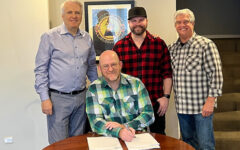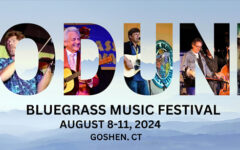Bob Webster, the WAMU/bluegrasscountry presenter of the Sunday morning programme Stained Glass Bluegrass, and regular contributor Richard F Thompson have collaborated to bring this story about the origins of the song The White Dove, the Stanley Brothers’ favourite.
An abridged version of the story will appear in a forthcoming edition of British Bluegrass News magazine.
 On this date (1 March) 60 years ago the Stanley Brothers recorded the now classic The White Dove for Columbia Records.
On this date (1 March) 60 years ago the Stanley Brothers recorded the now classic The White Dove for Columbia Records.
It was a song that Carter Stanley wrote while on the road according to what he told Mike Seeger, shortly before he passed away,
"I have done the most songs that I have written at night. A lot of times travelling; you know, nobody saying much, your mind wanders, one thing to another. I guess you’d call it imagination. I remember very well when I wrote ‘The White Dove’. We was coming home from Ashville, North Carolina, to Bristol, Tennessee, and I had the light on because I wanted to write it down and Ralph was fussing at me for having the light on. He was driving and he said the light bothered him, but he hasn’t fused any more about that."
About 10 years later Ralph confirmed that, when speaking to Bob Cantwell,
"It was one of his first songs. He was in the back seat of the car writing that and by the time we got to the radio station near home we had a verse and chorus worked out. I don’t know what caused him to think of the white dove except that he was studying on it, how it could affect you‚Ķ"
The White Dove was the second song recorded, among eight that they did that day during a session at Castle Studio, in the Tulane Hotel, in Nashville, Tennessee.
Three out of the four, including The White Dove, were given different treatment from the normal Stanley Brothers’ approach to their trio arrangement. At the suggestion of Art Wooten, they introduced a high baritone vocal, with Pee Wee Lambert and Ralph Stanley singing above Carter Stanley’s lead.
The White Dove was paired with Gathering Flowers for the Master’s Bouquet on a Columbia 78, No. 20577, released on 4 April, 1949. In addition to Carter Stanley (guitar), Ralph Stanley (banjo) and Lambert (mandolin), the recording featured ‚ÄòJay’ Hughes (bass) and Bobby Sumner (fiddle).
We know from symbolic traditions that white doves are associated with love and devotion, peace and unity. They mate for life and strive to return home. Although we’re not sure exactly what Biblical reference Crarer Stanley may have had in mind in writing the White Dove, there are several connections with scripture from the Holy Bible.
We learn in the Book of Genesis, Chapter 8, that after forty days of the great flood, Noah was still on the ark when he first released a raven to search for land. Then Noah sent forth a dove to see if the waters had subsided from the face of the ground, but the dove found no place to set her foot and returned to the ark. Noah waited another seven days and again sent out the dove. This time the dove returned with a freshly plucked olive leaf, a sign the waters were receding. Noah waited another seven days and sent forth the dove again and she did not return, an indication of having found land.
In the New Testament, the book of Mark, Chapter 1, we are told John the Baptizer met Jesus in the Jordan river and baptized Jesus. When Jesus came up out of the water the heavens opened and the Spirit descended upon him like a dove. This image is contained in the lyrics of Sweet Holy Spirit by Joe Isaacs and recorded by the Isaacs on their project Heroes.
Joe writes:
The sweet Holy Spirit is promised to you
It sat upon Jesus in the form of a dove
When John was baptizing God’s Dearly Beloved
Sweet Holy Spirit
Joe Isaacs
Chestnut Mound Music – BMI
From newadvent.org we find reference to two doves on a funeral monument sometimes signifying the conjugal love and affection of the parties buried there. Perhaps Carter Stanley was thinking of that symbol when he wrote:
The willows will hang their heads
I’ll live my life in sorrow
Since mother and daddy are dead
Carter Stanley
The New Advent website noted above also reflects that doves on a sarcophagus signify the peace of the departed soul, especially if it bears an olive branch in its beak. In the "White Dove" perhaps Carter Stanley was mourning in sorrow, as the white dove, since mother and daddy are dead, an image associated with home and family in the Clinch Mountains where the brothers were born and raised.
Jeanie Stanley, Carter’s ‚Äòbaby girl’ shared her thoughts about The White Dove ‚Ķ..
"My father wrote this particular song one night while he and Ralph were travelling. Ralph was aggravated because my father had the light on and it was bothering him. Then Ralph got miffed because my Dad had killed off their mother and father in the song when he heard it. Needless to say, it became one of my father’s most well-known songs. The words just touch your very soul and are like darts to the heart. It is probably Carter Stanley’s ‘signature song’ so to speak. I think it tells of a mournful yearning for what becomes lost to some in their quest to find themselves. The person my father refers to in this song has come full circle. It is basically autobiographical in nature. It was always one of my favorites."
It has been a song, as Ralph Stanley noted, that is “the backbone of the Stanley sound”. [Gary B Reid]
Recorded Sources –
- Columbia Master CO 40507 The Stanley Brothers & The Clinch Mountain Boys 1949-52 (Bear Family BCD 15564 AH)
- The Stanley Brothers – Clinch Mountain Bluegrass (Vanguard 77018-2) Recorded at the 1964 Newport Folk Festival
- The Stanley Brothers Stanley Series Volume 4 Number 1 (Copper Creek CCCD 5513) Recorded at New River Ranch, Rising Sun, Maryland – July 29, 1956
- The Stanley Brothers And The Clinch Mountain Boys The Essential Gospel Masters (Varese Sarabande 302 066 669 2) includes the 1959 King version of White Dove [King single 5233]







